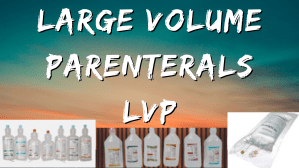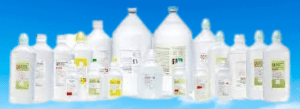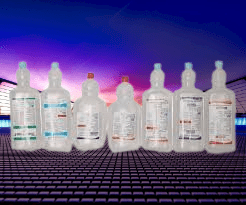Large Volume Parenterals (LVPs) are pharmaceutical preparations that are administered parenterally in relatively large volumes. LVPs typically include intravenous solutions, such as saline or dextrose solutions, that are used for fluid replacement, maintenance, or to deliver medications over an extended period. Explore the uses and benefits of LVPs in medical settings for efficient and controlled administration of fluids and medications.
Large Volume Parenterals definition
Large Volume Parenterals (LVPs) refer to pharmaceutical preparations that are administered parenterally (outside the digestive tract) in relatively large volumes. These preparations are typically sterile solutions or suspensions packaged in bags or bottles. LVPs are commonly used for intravenous (IV) fluid replacement, maintenance therapy, or for the slow infusion of medications over an extended period.
LVPs are designed to provide larger volumes of fluids or medications to patients who require significant hydration or prolonged drug delivery. These products are often used in hospital settings, critical care units, and surgical procedures.
Common examples of LVPs include intravenous solutions such as Normal Saline (0.9% sodium chloride), Ringer’s Lactate, Dextrose solutions, and various electrolyte solutions. These formulations are manufactured under strict aseptic conditions to ensure sterility and minimize the risk of contamination.
The administration of LVPs requires proper handling and monitoring due to the larger volumes involved. Healthcare professionals carefully regulate the rate of infusion to ensure patient safety and maintain fluid and electrolyte balance.
Overall, LVPs play a crucial role in medical practice by providing large volumes of fluids, electrolytes, and medications intravenously for various therapeutic purposes.
The manufacturing process of Large Volume Parenterals
The manufacturing process of Large Volume Parenterals (LVPs) typically involves several stages to ensure the production of sterile and safe products. Here is a general overview of the manufacturing process for LVPs:
- Formulation: The formulation of LVPs involves selecting the appropriate ingredients and determining their concentrations. This includes determining the composition of the intravenous solution, such as saline, dextrose, or electrolyte solutions, as per the desired specifications.

- Preparation of Components: The necessary components, including active pharmaceutical ingredients (APIs), excipients, and solvents, are obtained and prepared according to established quality standards.
- Mixing and Dissolution: The components are mixed or dissolved in suitable vessels or tanks. This step ensures that the ingredients are uniformly distributed and dissolved to achieve a homogenous solution.
- Sterilization: Sterilization is a critical step to eliminate any microbial contamination. The most common methods for sterilizing LVPs include terminal sterilization, such as autoclaving, or aseptic processing, which involves filtering the solution through sterilizing filters.
- Filling and Packaging: The sterile LVP solution is filled into bags or bottles using aseptic techniques and equipment. The containers are then sealed to maintain the sterility of the product. The packaging may include additional features like tamper-evident seals and labeling with relevant information.
- Quality Control: Throughout the manufacturing process, rigorous quality control tests and inspections are conducted to ensure that the LVPs meet the required standards for sterility, pH, osmolarity, particulate matter, and potency. These tests help verify the safety, purity, and efficacy of the final product.
- Batch Release and Distribution: Once the LVPs pass all quality control tests, they are released for distribution to healthcare facilities or pharmacies for use in patient care.
It’s important to note that the manufacturing process may vary slightly depending on the specific requirements, regulations, and quality standards of different regions and pharmaceutical companies. Strict adherence to Good Manufacturing Practices (GMP) and quality assurance measures is critical throughout the manufacturing process to ensure the production of high-quality and safe LVPs.
Large volume parenterals examples (LVP)
Large Volume Parenterals (LVPs) encompass a wide range of intravenous solutions used for fluid replacement, maintenance therapy, and medication administration. Here are some common examples of LVPs:
- Normal Saline (0.9% Sodium Chloride): A sterile solution containing sodium chloride in a concentration that matches the physiological level in the body. It is used for fluid replacement, hydration, and dilution of medications.

- Dextrose Solutions: Solutions containing various concentrations of glucose (dextrose), such as 5%, 10%, or 50%. These solutions provide a source of energy and can be used for fluid replacement, nutritional support, or as a vehicle for the administration of medications.
- Ringer’s Lactate Solution: A balanced electrolyte solution containing sodium chloride, potassium chloride, calcium chloride, and sodium lactate. It is commonly used for fluid resuscitation, maintenance therapy, and correcting electrolyte imbalances.
- Intravenous Electrolyte Solutions: These solutions contain specific electrolytes like potassium, magnesium, or phosphate to address specific deficiencies or imbalances in the body.
- Total Parenteral Nutrition (TPN): A specialized LVP formulation that provides a balanced mixture of nutrients, including proteins, carbohydrates, fats, vitamins, and minerals. TPN is used for patients who are unable to receive adequate nutrition through the digestive tract.
- Albumin Solution: A plasma protein solution derived from human plasma or albumin from other sources. It is used for expanding blood volume, maintaining colloid osmotic pressure, and in certain medical conditions.
- Parenteral Nutrition Additives: LVPs may also include separate vials or containers for adding specific additives, such as vitamins, trace elements, or lipid emulsions, to customize the nutritional content based on patient needs.
These examples represent a fraction of the LVPs available in the market. The specific LVPs used in medical practice may vary depending on the region, healthcare facility, and patient requirements.
Volume or Range of Large Volume Parenterals (LVPs)
Large Volume Parenterals (LVPs) are pharmaceutical preparations administered parenterally in relatively large volumes. The specific volume or range of LVPs typically exceeds the volumes of Small Volume Parenterals (SVPs). LVPs are commonly available in volumes ranging from 100 mL to several liters.
In the context of intravenous (IV) solutions, LVPs are usually supplied in flexible plastic bags (commonly referred to as IV bags) that can hold volumes of 250 mL, 500 mL, 1 liter (1000 mL), or even larger. These larger volumes are necessary for fluid replacement, maintenance therapy, and the slow infusion of medications over an extended period.
It’s important to note that the specific volumes and packaging options for LVPs may vary based on regional regulations, healthcare facility preferences, and patient requirements. The selection of the appropriate volume depends on the specific medical indication and the patient’s fluid and medication needs.
Difference between large volume parenterals and small volume parenterals
| Aspect | Large Volume Parenterals (LVPs) | Small Volume Parenterals (SVPs) |
|---|---|---|
| Volume Range | Typically larger volumes, ranging from 100 mL to several liters | Relatively smaller volumes, ranging from a few mL to around 100 mL |
| Administration | Administered parenterally in relatively large volumes | Administered parenterally in smaller volumes |
| Packaging | Supplied in flexible plastic bags (IV bags) or bottles | Packaged in vials, ampoules, or prefilled syringes |
| Application | Used for fluid replacement, maintenance therapy, and prolonged infusions | Used for precise medication dosing and small-volume administration |
| Examples | Normal Saline, Dextrose solutions, Ringer’s Lactate, TPN | Heparin, Antibiotics, Antiemetics, Electrolyte solutions |
| Route of Administration | Typically administered intravenously (IV) | Administered intravenously (IV), intramuscularly (IM), or subcutaneously (SC) |
| Manufacturing Process | Sterile formulation, mixing, sterilization, filling, and packaging | Sterile formulation, mixing, sterilization, filling, and packaging |
| Common Setting | Hospital settings, critical care units, surgical procedures | Hospital settings, clinics, home healthcare |
Types of Large Volume Parenterals
There are various types of Large Volume Parenterals (LVPs) used in medical practice. Here are some common types:
- Intravenous (IV) Fluids: These include solutions such as Normal Saline (0.9% sodium chloride), Ringer’s Lactate, Dextrose solutions, and various electrolyte solutions. They are used for fluid replacement, maintenance therapy, and to correct electrolyte imbalances.
- Total Parenteral Nutrition (TPN): TPN solutions are comprehensive formulations that provide a balanced mixture of nutrients, including proteins, carbohydrates, fats, vitamins, and minerals. TPN is used for patients who are unable to receive adequate nutrition through the digestive tract.
- Albumin Solutions: These solutions contain albumin, a plasma protein derived from human or other sources. They are used to expand blood volume, maintain colloid osmotic pressure, and in certain medical conditions such as hypoalbuminemia.
- Parenteral Electrolyte Solutions: These solutions contain specific electrolytes such as potassium, magnesium, or phosphate to address deficiencies or imbalances in the body.
- Irrigation Solutions: LVPs include sterile irrigation solutions used for wound irrigation, surgical procedures, and cleaning body cavities. Examples include Normal Saline Irrigation and Lactated Ringer’s Irrigation.
- Contrast Media: Certain LVPs serve as contrast agents for medical imaging procedures, such as iodinated contrast media used in computed tomography (CT) scans or angiography.
- Blood Products: While not technically LVPs, blood products such as packed red blood cells, platelets, plasma, and albumin solutions are administered intravenously in larger volumes for blood transfusions or to address specific medical conditions.
These are just a few examples of the types of LVPs commonly used in medical settings. The specific types and formulations may vary based on regional regulations, healthcare practices, and patient needs.
Advantages and disadvantages of large volume parenterals
| Advantages | Disadvantages |
|---|---|
| Provides efficient and controlled administration of fluids. | The potential risk of fluid overload. |
| Convenient for administration over extended periods. | Increased risk of contamination during handling and storage. |
| Suitable for fluid replacement and maintenance therapy. | Limited portability compared to Small Volume Parenterals (SVPs). |
| Can be used for the slow infusion of medications. | Requires careful monitoring of infusion rates and patient response. |
| Allows for precise dosing and delivery of medications. | Higher cost compared to oral medications. |
| Offers flexibility in customizing electrolyte concentrations. | Potential for adverse reactions or side effects. |
| Supports the administration of specialized nutrition through TPN. | Requires skilled healthcare professionals for proper administration. |
| Widely available and commonly used in medical settings. | Potential for incompatibilities with certain medications. |
Frequently Asked Questions
What is the typical volume range of LVPs?
Answer: LVPs are available in volumes ranging from 100 mL to several liters.
What are some common types of LVPs?
Answer: Common types of LVPs Large Volume Parenterals include intravenous fluids (e.g., Normal Saline), Total Parenteral Nutrition (TPN) solutions, and albumin solutions.
How are LVPs typically administered?
Answer: LVPs Large Volume Parenterals are usually administered intravenously (IV), although they may also be administered intramuscularly (IM) or subcutaneously (SC) in some cases.
What is the purpose of LVPs in fluid therapy?
Answer: LVPs Large Volume Parenterals are used for fluid replacement, maintenance therapy, and to correct electrolyte imbalances in patients.
How are LVPs manufactured to ensure sterility?
Answer: LVPs Large Volume Parenterals are manufactured under strict aseptic conditions, including sterile formulation, mixing, sterilization, filling, and packaging processes.
What are some common challenges in the handling and storage of LVPs?
Answer: Challenges include the potential risk of contamination during handling and storage, the need for proper temperature control, and protection from light exposure.
What quality control measures are taken during the manufacturing of LVPs?
Answer: Rigorous quality control tests and inspections are conducted to ensure sterility, pH, osmolarity, particulate matter, and potency of LVPs Large Volume Parenterals.
How are LVPs typically packaged for distribution?
Answer: LVPs Large Volume Parenterals are commonly packaged in flexible plastic bags (IV bags) or bottles that are sealed to maintain sterility and labeled with relevant information.
What precautions should be taken during the administration of LVPs?
Answer: A: Healthcare professionals should monitor infusion rates, and patient response, and check for incompatibilities with other medications.
What are the advantages of using LVPs in medical practice?
Answer: Advantages include efficient administration of fluids and medications, convenience for prolonged infusions, and precise dosing and delivery of medications.



1 thought on “Large Volume Parenterals LVP 2023”